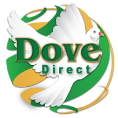Dove Direct Print and Marketing Blog - "Tracking B2B Sales Metrics That Matter"
Welcome to the Dove Direct Print and Marketing Blog. Today's post, "Tracking B2B Sales Metrics That Matter," dives into the metrics and methods B2B organizations should track for success. All businesses should track various KPIs, and depending on the industry sector, there could be variables that are unique to each business ROI. In the case of monitoring B2B sales metrics, the selling process is more involved than B2C selling and requires a longer sales cycle, and typically, higher price points, which raises the stakes.
You will find that most successful B2B sales teams have developed sales metrics that they track regularly. Some B2B sales organizations track weekly, such as television spot sales, or radio spot sales, etcetera. However, it can become a dangerous proposition to forgo tracking KPIs when sales are booming. Since sales fluctuate, regular monitoring leads to better performance and productivity.
Developing KPI metrics for a B2B sales team can be difficult at first glance, however, once you identify the primary metrics that should be in the mix, the task becomes more succinct and easier to measure.
The sales team will also benefit from tracking specific metrics. By establishing and tracking select metrics, you shine a light on focus areas that should be in every sales pitch. Salespeople armed with better sales presentations are better equipped to respond and close deals that may emerge. In addition, the KPI tracking process helps the B2B sales team understand the organization's bottom line, the health of the business, and how to target potential growth areas.
Key B2B Sales Metrics
The following is a shortlist of the KPIs every B2B sales team should track. Secondly, B2B sales tracking is more efficient when implementing the use of a CRM tool, although a spreadsheet can work.
- Sales Total: Is the total amount of revenue generated from sales that happened over a particular period. (This can be done weekly, bi-weekly, monthly, quarterly, and annually)
- New Business Sales: This metric indicates the number of new customers and the percentage of new business revenue contributed to the overall sales total. A simple formula to use to calculate this is (Sales from New Business/Total Sales)*100.
- Category Sales: Businesses need to understand how each product set performs and capture the products or categories that provide the most sales, flat growth, or no sales.
- Net Profit Margins: Another key metric are the profit margins. Over and above sales, are the profit margins determined by (Net Income / Net Sales )*100. This metric measures the profit you make from all sales.
- Customer Sentiment: Given the Internet and the ability for customers to rate your offerings and post that information online, sales teams should track customer sentiment. Your goal is to determine if your customer will recommend your offerings to others. You can track customer sentiment by asking customers to rate the offering on a scale of 1-10, from worst to best. You might strive for seven or better, knowing that a score of 7 or more leads to a customer recommendation. By tracking this metric, you will have a better understanding of customers who are likely to recommend or discourage colleagues or friends from buying or passing on your offerings.
As you can see, having or investing in a CRM tool can make this process much more efficient and timely.
Tracking Lead Sources
Lead sources can come from a variety of avenues, some being internal while others are external. Internal lead generation can come from a list of previous clients or from industry lists that reflect similar product purchases. By understanding where the majority of your leads are coming from, you can increase the efficiency of your B2B sales team.
Categorizing sales leads serves as another tracking mechanism for lead sources. Categories can prove to be particularly efficient for managing the sales team time. For example, if more qualified leads are generated by contact forms or by social media responses, then sales reps should focus on engaging those lead prospects as opposed to cold calling or phone sales solicitations.
Understand Lead Source Percentages
After you track and categorize the lead sources, the next KPI is how the revenue breaks out for each lead generation category. By accounting for the sources of revenue, you can determine which methods are the most effective and identify areas to increase or decrease.
As an example, let's say the business generated $100k over three months. You can break out the sales based on account-based marketing (ABM), cold calling, online, and repeat business. If for example, ABM generated $30K, Cold Calling generated $15K, Social Media/Online efforts generated $30K, and Repeat Business generated $25K, you may want to select any one of the categories to focus on based on your lead source percentages.
Prospect Lead Response Time
In this nano-second world, response time is critical. When a prospect has engaged on any level, whether it's downloading a free offer or white paper, or responding to a social media post or an email, the response time makes all the difference. In a perfect world, real-time response rates have a much better success rate when the sales rep follows up with the prospect promptly.
According to a Harvard Business Review study, companies on average respond to leads somewhere within 42 hours of an inquiry, if they respond at all. That is far too long for response time to effectively garner a prospect's interest and turn that prospect into a qualified lead.
Here are three ways to track average lead generation response times, and you may notice that all three involve strategy:
- Email Workflow - Leads that engage via email can often get lost regarding response times. A simple solution is to have an automated email tool, such as Constant Contact or Mail Chimp, among others. Properly configured email automation that delivers lead requests to the right sales rep is a more effective option over bulk sending requests addressed to a shared mailbox.
- Social Media Monitoring - It is vital for businesses that use social media as a marketing tool to continually monitor prospect inquiries generated through social media channels. Being able to respond in a matter of minutes will engage the brand with interested leads, and capture their attention with the next steps.
- ChatBots - When a lead arrives at your website, completes a form and waits for a response, precious time could be lost before following up the lead. Investing in a live chat tool for your website can help solve the response time, in that (1) It provides a mechanism for reps to chat with leads in real-time, and (2) chatbots can be preprogrammed with answers to FAQs, along with giving a sales rep name for followup. In addition, sales reps will be able to respond quickly as chatbots can be set up to forward emails to the sales team, including specific reps assigned to respond to chatbot inquiries.
Lead Pipeline Timing
Measuring the time to close a lead opportunity is an efficiency metric that sales should monitor. This metric focuses on how long the sales process takes to move the prospect from the initial contact to closing the deal and becoming a customer.
The longer the sales process takes to complete, the more likely prospects will leave the sales funnel. Optimizing the sales process can help to reduce prospects from leaving the sales funnel before a rep closes the deal.
Sales managers routinely report what's in the prospect pipeline, and of those in the pipeline, which ones are most likely to buy, which require more nurturing, and of course which will land on the non-buy list. The sales lead pipeline has a velocity which is time-dependent.
The time it takes to close is the sales velocity pipeline. You can calculate the sales velocity pipeline by segmenting the sales pipelines by market size. You can set this up by category; i.e., small market, midsize market, and enterprise-level pipelines.
A simple formula that one can use to track the sales lead pipeline metric is: Sales Velocity = Number of Opportunities x Deal Value x Win rate / Sales Cycle Length.
For example, in a given month, a B2B commercial print sales rep has 25 prospective opportunities in the pipeline. The deal value is $20,000. The win or conversion rate is 20%. The average sales cycle is 40 days. In other words, Sales Velocity = ((25 x 20,000) x 20%) / 40). Applying the formula means that the sales velocity pipeline for the rep is $2,500/per month.
Customer Procurement Costs
To acquire new business prospects that convert into paying customers requires investments in both time and money. Usage of these resources is known as the CAC (Customer Acquisition Costs). The CAC is the average cost to acquire a new customer. Tracking the average costs to acquire new customers is a metric that impacts the ROI of a business.
The following formula is a good starting point for determining CAC.
Customer Acquisition Cost = Dollars Invested Acquiring New Customers over a specific Timeframe/Total Number of Customers Converted Over that Same Timeframe)
Let's say a business spent $16,000 targeting new customers and as a result converted 35 customers over that period. Total acquisition cost per customer is $457 or CAC = 16K/35.
The Net-Net
Sales efficiency is directly related to KPI metrics that matter. B2B organizations that set up and track data based on sales will fare far better by analyzing sales efficiency over time. Metrics backed by sales data is the mantra of the universe when tracking B2B sales for your industry sector. Thanks for reading "Tracking B2B Sales Metrics That Matter."
Let's have a conversation about direct mail marketing strategies, printing, transactional documents, variable digital printing, brand equity and unified marketing collateral during our next Open House. We invite you to join us on Thursday, September 26, 2019, for an hour or two, anytime between 10:30 am to 3:30 pm. Let us show you how to improve your document processes to optimize your workflow, reduce your costs, and maximize your organization's printing, letter shop, and mailing capabilities. Dove Direct has an official USPS certified bureau located within our offices that will save you time and money. Moreover, if you bring us your files, we will create a demo file for you. For more information, call Carla Eubanks at 404-629-0122 or email Carla at This email address is being protected from spambots. You need JavaScript enabled to view it..
Dove Direct, your Atlanta based print and mail solutions provider offers organizations end-to-end data, printing, and mailing solutions: Data Management, Variable Digital Printing, LetterShop and Fulfillment, Fully Automated MLOCR Presort Bureau, Marketing and Production Management Support and Secure Data Life Cycle Management.
If you don't want to wait for the Open House, you can reach Dove Direct today by calling 404-629-0122 or use the contact form for Dove Direct.




